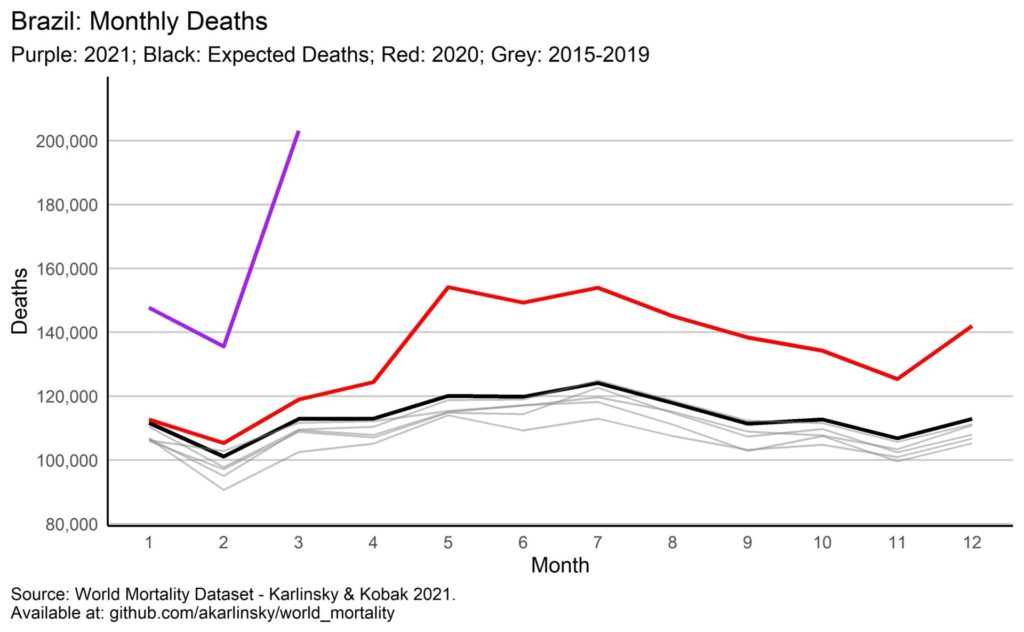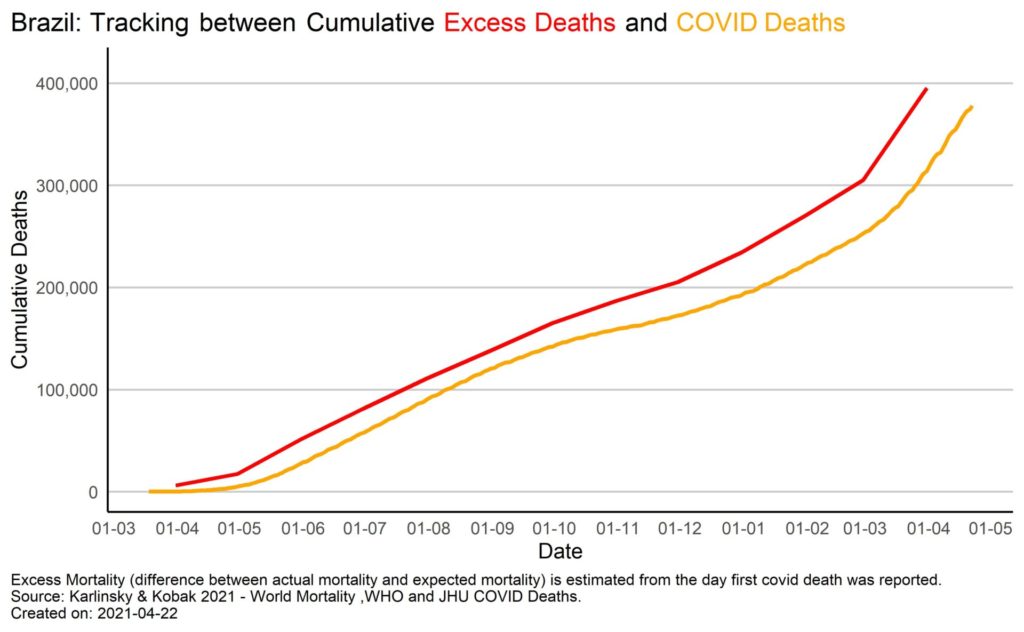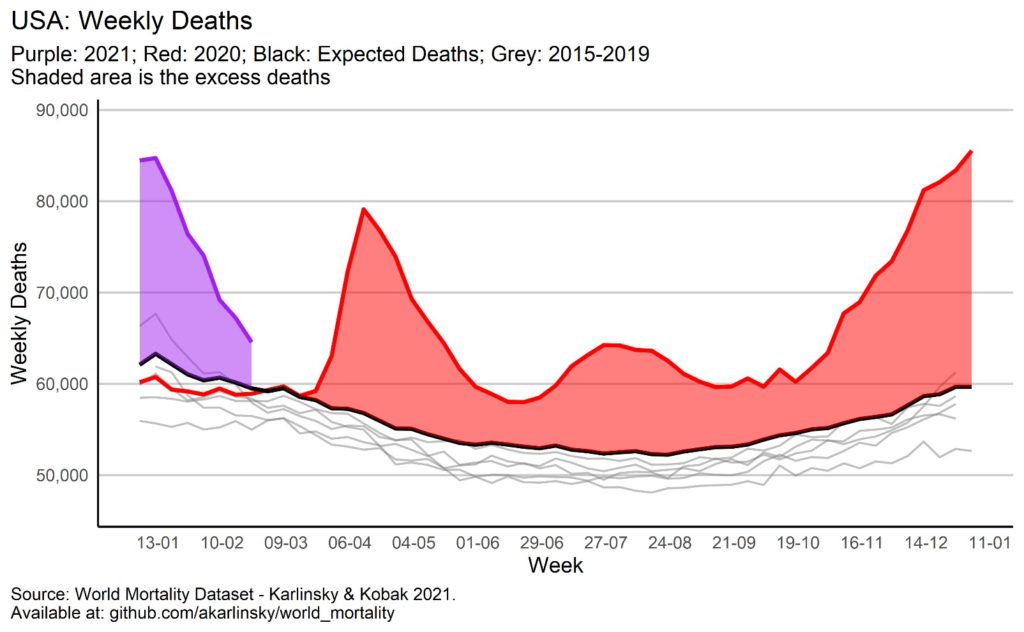[Editor’s note: Today we introduce a new guest poster discussing some issues with excess mortality calculations in Brazil, Ariel Karlinsky. Welcome!]
If you follow the news, you probably heard that the COVID-19 situation in Brazil is dire, with cases and deaths on a sharp upward trajectory.
Could this be pure scare-mongering? Informing us only of the number of COVID-19 deaths daily – much like if they would inform us of the daily number of people who died from traffic accidents, cancer or even the flu – the numbers would be even higher! This is the byline promoted by many, including persons much more distinguished than I, such as Chemistry Nobel Laureate Michael Levitt. Levitt is one of the key people in denial of, or more politely “minimization” of, COVID-19 and its effects. He has downplayed the significance of the pandemic for over a year. His claims regarding the COVID situation have included things like:
- In mid-March 2020, he said “I’ll be surprised if more than 10 Israelis will die of COVID”. Current reported COVID deaths in Israel are over 6,300.
- In July 2020, he said “COVID19 will be done in 4 weeks with total reported deaths below 170,000”. Current reported COVID deaths in the US are over 560,000.
But what is really happening?
The importance of excess mortality
There’s a very-well-established metric (dating back to the 19th century, at least! [PDF]) that can demonstrate the impact of COVID-19 on a population. It’s called “excess mortality”: the number of deaths over and above those expected in a certain country or area during a week, month, quarter, or year. It is incredibly easy to predict the expected number of deaths; in a sense, it behaves like the weather – winters are colder (and deadlier) than summers. There’s variation and some trend, but you can bet that August in Miami, Florida is going to be nice and sunny. Based on the expected weather for a time period, we can identify when an event is a significant outlier – like when the temperature in Miami drops below freezing in the middle of August.
Levitt attempted to estimate the increase in deaths in 2020 in Brazil and found that it was “…7%… same as EuroMOMO (7.5%) & half USA (13.2%)… Pity newspapers are not a bit smarter…”.
Just 60 min of Excel, the results are gratifying.
All-cause death in Brazil is increasing by 90,000 per year. When accounted for, the excess death in 2020 is 94,000 or 7% of natural death. Same as EuroMOMO (7.5%) & half USA (13.2%).
Pity newspapers are not a bit smarter… https://t.co/xxlc39deS4 pic.twitter.com/s7blCRTZiX
— Michael Levitt (@MLevitt_NP2013) April 11, 2021
There are several glaring flaws in Levitt’s analysis that I will detail below. In short, I can tell you that 2020 deaths in Brazil are 17.5% higher than expected (with Levitt’s own method) and that deaths from March 2020 to March 2021 are 26.7% higher.
What Levitt gets wrong in Brazil
Wrong data for 2015 to 2019
First and foremost, Levitt uses a very incomplete data source for deaths in Brazil – the automatic reports published by the Civil Registry. The CR is part of an ongoing reform in many Latin American countries to modernize its system to track vital events (such as births, marriages, and deaths). Since it was introduced pretty recently, it suffered from a severe under-registration in its first years. For example, total deaths in 2015 were registered at 905,549. Just 5 years later in 2019, it registered 1.266 million deaths – a horrifying 40% (!) increase with no extreme events or reasons to justify it. When the numbers are “too good to be true”, maybe it’s because they are. This difference is not due to a natural increase or variation in annual deaths, but an artificial spike caused by an increase in coverage and registration.
Had Levitt looked around a bit, he would have found official deaths reports by the Brazilian Ministry of Health (also known as SUS or SIM), which shows higher, but more plausible, numbers compared to every year available for the CR (1.264 million deaths in 2015, 1.349 million deaths in 2019).
Using the CR data source throughout, Levitt estimates a linear trend on 5 annual data points and obtains an extremely upward-biased prediction for 2020 (“an increase of 90K per year”) of 1.361 million deaths. Subtracting that expectation from the CR figure for 2020 of 1.454 million deaths, he obtains this “7% increase”.
It should be noted that a 7% yearly increase in mortality is HUGE. It does not happen regularly. Annual deaths usually vary by no more than a couple of percentage points or fractions thereof.
Wrong data for 2020
Deaths registration in the CR has picked up in 2020, but it is still highly incomplete. The CR figure for number of deaths in May 2020 is 132,240, while the latest data released by the Brazilian Ministry of Health shows May 2020 to be at 154,135.
The CR has its uses however, as it is currently the only “real-time” publicly-available death registration mechanism in Brazil, where the number of deaths reported is updated daily. While SIM has data only up to May 2020, the CR already has info for March 2021.
My colleague Dmitry Kobak and I, with the help of Brazilian researchers Marcelo Oliveira and Otavio Ranzani, have integrated both of these data sources as part of our international all-cause mortality dataset World Mortality. We use the ratio between total deaths reported in SIM to those reported in CR from January to May 2020 (1.1). This allows us to have very up-to-date figures, while also correcting for the under-registration which exists in the CR even in 2020.1
Combining these two sources, our estimated total deaths in Brazil in 2020 stand at 1.603 million. Since the actual, final, published figures for 2015-2019 are much higher than those in the CR, the yearly trend between them is much smaller (17.8k per year) and using Levitt’s own method – 2020 is 17.5% higher than expected.
Why so annual?
In ordinary times, we are used to thinking and operating in useful time frames – a day, a month, a year. In ordinary times, researchers mostly care for annual number of deaths. COVID-19 cares not for our ways and did not start in Brazil on January 1st 2020, and did not end on December 31st. When we look at the number of deaths in Brazil from 2015 to 2021 by month, we can see that 2020 starts as quite a normal year, with deaths in January and February very much in line with previous years and our prediction (based on the monthly average for seasonality with the addition of a yearly trend). In March, the death count in 2020 started rising, a gap between expected deaths began to form, and it has not closed since.

Moreover, in 2021 – this gap increases. Deaths in January and February 2021 are far above expectation, with deaths in March 2021 – one year since SARS-CoV-2 began to spread in Brazil – crossing 203,000 persons. This monthly figure is 80% above expectation.
When we sum excess deaths since COVID-19 started in Brazil to our latest data point of March 2021, we arrive at slightly more than 395,000 EXCESS deaths. This is 26.7% above expected.
These excess deaths go in tandem with reported COVID-19 deaths, but are slightly higher. These excess deaths are no doubt caused by SARS-CoV-2, as it spreads more and more in the country, leading to more cases, and deaths, due to COVID-19.

Levitt’s mishandling of excess deaths in America
This is not the first time Levitt has failed to perform even minimal vetting of data he uses to downplay the extent of the harm done by COVID-19. Several times, he has used weekly CDC all-cause mortality data in the US to claim that the pandemic is over:
US COVID19 will be done in 4 weeks with a total reported death below 170,000. How will we know it is over? Like for Europe, when all cause excess deaths are at normal level for week. Reported COVID19 deaths may continue after 25 Aug. & reported cases will, but it will be over. https://t.co/lnpxZ3bHIy
— Michael Levitt (@MLevitt_NP2013) July 25, 2020
The reality is that the US has been in a state of significant excess mortality since mid-March of 2020:

So how did Levitt see “deaths coming back to baseline” during 2020? He used incomplete data. The CDC continuously reports deaths during weeks and includes a small indication that data for certain weeks is incomplete. Even without seeing this, it shouldn’t be hard to miss – when weekly deaths during a pandemic fall to less than the minimal weekly deaths since 2015, the best course of action is to WAIT and see if this is true, or just a mirage created by delayed registration of real-time data.
Conclusion: Properly reported excess deaths show the truth
In conclusion, in Brazil, America, and many other countries around the world (our detailed analysis of excess mortality in 89 countries and territories is available here), the appropriate use of excess death statistics show the clear impact of COVID-19. Excess mortality is much higher in both nations than Levitt claimed and they go hand-in-hand with COVID-19 deaths.
1 We believe the 1.1 ratio is a lower-bound estimate for under-registration in RC, as evident by the ratio in May 2020 which stands at 1.16 and by the SIM data itself being preliminary.

